 I’m very pleased to announce that a product so noteworthy that I would love to have it on my own has arrived on the market. It’s not my usual way of categorizing audiophile innovations. Usually the division is more reasonable like expensive, medium, cheap or extraordinary, good, bad. Surely this way is more rational and professional, but at times one experiences something called an impulse. Such spontaneous reactions reflect wisdom derived from subconsciousness, which ignores the procedures established by the ratio, hitting you straight from emotional sphere and something called wanting. Whether you want something or avoid something is not a question of deliberate behavior, in any case, not among those who react spontaneously as opposed to those calculated people who try to win the world with cleverness. Admittedly, the simple-minded “I want” can be just a caprice, but I’m not talking about temporary whimsies like when you feel like having a donut, I’m talking about an internal urge that appears on its own and prevails. Like when you yearn to buy something and you just can’t do without it. Some say that the best way to fall out of love is to get married, but that’s plain bullshit. It might happen sometimes, but more often when you really love somebody, you want to be with that person for the rest of your life. Of course I don’t want to talk you into building a serious relationship with ifi PRO iCAN headphone amplifier. I just want to point out that it is special in that sense that it can generate this strong desire that can be satisfied only with purchase.
I’m very pleased to announce that a product so noteworthy that I would love to have it on my own has arrived on the market. It’s not my usual way of categorizing audiophile innovations. Usually the division is more reasonable like expensive, medium, cheap or extraordinary, good, bad. Surely this way is more rational and professional, but at times one experiences something called an impulse. Such spontaneous reactions reflect wisdom derived from subconsciousness, which ignores the procedures established by the ratio, hitting you straight from emotional sphere and something called wanting. Whether you want something or avoid something is not a question of deliberate behavior, in any case, not among those who react spontaneously as opposed to those calculated people who try to win the world with cleverness. Admittedly, the simple-minded “I want” can be just a caprice, but I’m not talking about temporary whimsies like when you feel like having a donut, I’m talking about an internal urge that appears on its own and prevails. Like when you yearn to buy something and you just can’t do without it. Some say that the best way to fall out of love is to get married, but that’s plain bullshit. It might happen sometimes, but more often when you really love somebody, you want to be with that person for the rest of your life. Of course I don’t want to talk you into building a serious relationship with ifi PRO iCAN headphone amplifier. I just want to point out that it is special in that sense that it can generate this strong desire that can be satisfied only with purchase.I have to clarify one more thing: I’m not saying I would get rid of the amp I have now, the good old Twin-Head standing behind me. I just whish I had ifi PRO iCAN at the computer – and I wish it so much. Because it’s really something. I’m sure there are much better ones, like RudiStor Dual Mono or Appex Pinnacle. But first, they are more expensive (much, much more) and second, they are not as handy. Because this one is just perfect – not too big or too small – and it has lots of power supported by tubes, and when you connect it to a good converter, using a good interconnect and plug some nice headphones in, the result is so fantastic that the urge to have it is starting to burn you.
Design and build quality
ifi has been already mentioned so many times that it would be a waste of time to go all over it again saying that it’s from London and specializes in audiophile mini stuff. However, the latter is important as it brings a change. Not a radical change – like in the case of the previous, original company, when Abbington Music Research, producing enormous blocks, decided to start a sub-company, ifi, focusing on portable devices that gain on popularity – but still a noticeable, quite prominent change. Because so far ifi stood for “micro” and “nano”, something very little, almost hardly noticeable. These devices fit into a pocket and were battery powered. Now the stuff from PRO series is also not big, but if you want to fit it in a pocket, you have to wear cargo pants. You need both hands to carry it and the device is well visible on a desk, and the first thing that catches the eye is the abundance of slots and knobs.
The front panel is packed with so many things, you cannot put a finger without touching any button, knob or slot. If you want to stroke iCAN with love, you can rub the top. But remain careful, as on the right, at the back there is a magic tube eye and ventilation grille to cool down the tubes hidden under the eye. AMR has decided that tubes are a must have. And it was a good decision, at least when it comes to traditional equipment. Admittedly, it is possible to use a transistor or a digital amplifier, which is best visible in the amp from Avantgarde or monoblocks from Accuphase. But such solutions have to be highly advanced, whereas more traditional equipment, not for tens or hundreds thousands, preferably should have tubes. It is like grease in a bearing, making everything work better and the music sound cleaner. Add a tube to a signal path and all improves, and improvement is the key. For your interest, AMR is referring to some German research claiming that the presence of tubes increases the feeling of happiness and causes a drop in suicide rates, but I have already mentioned that so lets not delve into it again. However, the fact is quite significant, pointing in the favor of lamps. But here they are used in a combined way, as expected of ifi. The packed front panel includes a small slider with three icons describing three states. The state on the left means no lamps, in the middle – partly with lamps, on the right – with lamps turned on to the full. The latter also reduces the unwanted feedback to the minimum, further enhancing the whole show. You will get a detailed comparison of the three states soon, now about the remaining items on the front panel.
First on the top left side is a small “ifi” symbol – highlighted, with “Pro” lettering below. Further below, on the bottom, there’s a small on/off button, which turns the device on and lights up the symbol. You can see the device is on not by the highlighted symbol, but by glowing tubes under the magic eye. These are, as I’ve mentioned, on the right, towards the back, with some ventilation grills on the top and at the side. At the center of the grille you can read “NOS General Electric 5690” written around the glass eye, letting you know what tubes are underneath.
At both ends of the front panel, there are two large knobs. The left one is for selecting the source, whereas the right one is a potentiometer – offering significant resistance, adjustable also with the remote. Next to each knob there’s a smaller one, creating a nice symmetry. The small knob on the left is XBass regulator with four positions, the one on the right is 3D, also with four positions. Between the two there are three slots, likewise placed in a witty manner. The two side ones are for 6.3 mm jack, with build in balanced 3-pin slots. This peculiar solution is popular in the USA, that’s why it is present here. In the middle there is a single 4-pin slot, dedicated for the more and more popular cables. It’s worth mentioning that Sennheiser and Beyerdynamic have recently introduced their flagship models, improving the previous versions. And one of the greatest improvements is the 4-pin at the end of balanced cable for balanced sound. So it fill perfectly fit in the slot and the companies were probably acting in collusion. But that’s not all, there are two slots below: one balanced and one ordinary 3.5 jack. So we have a full house, with everything smartly designed and with great power supply. A dream come true for every headphone enthusiast – nothing left but to plug in. The overall balance is topped off with one more thing. To the left there’s this tube slider, and at the opposite side there is a slider for gain selection (0, +9, +14 dB).
Everything put together creates a nice and functional composition – symmetric, neat, in metallic gray, with narrow indentation at the bottom to break the line.
The perfect harmony of the front panel is supplemented by functional back with two XLR and three RCA inputs, with a pair of outputs of each type – those familiar with the subject know this means the amp can be used either as a preamplifier or buffer. There’s also power input. The power source is external, rather big, with a white light that glows too strong. In the future there will be a separate power unit in the form of a stand-alone device, but nothing much is known about it, so lets forget about it for now. Of course there will also be a dedicated DAC, but also shrouded in mystery, so for now lets simply enjoy the amp.
And there’s a lot to enjoy as there is also ESL-link connector for plugging in a special energizer module. So it will be a second (after the German Audiovalve Luminare) headphone amplifier that will be suitable for any headphones: planar, electrostatic, AMT, dynamic. Also fully compatible when it comes to power: it will be good with the power-consuming over-the -ear headphones as well as the low-energy in-ear headphones.
We still have to discuss the technologies used and estimate the price. With maximal amplification in balanced mode, ifi PRO iCAN can deliver 14 W per canal to the output, which is exceptionally high – sufficient even for the once most demanding AKG K1000 headphones and the now most demanding Abyss 1266. For the unbalanced outputs the value reaches 4.8 W, so also very high. The amplification can be on pure transistor level, using solely J-FET and MOS-FET transistors. But you can also use tube input, using two NOS General Electric 5690 tubes. The latter can also be used in two modes – with maximum feedback reduction or without it.
The preamp is based on super fast bipolar transistors, whereas the output stage, depending on power demand, automatically switches between A and AB class.
The technical parameters are astounding. ifi PRO iCAN’s frequency response is 0.5 – 5 000 000 Hz (+-3 dB) at signal to noise ratio 142 dB, whereas THD for transistor mode is below 0.004%, for tube it is below 0.005% and for tube+ it is below 0.01%. At the same time, the manufacturer emphasizes that the last mode is characterized by sounds very typical of tubes, so tube enthusiasts should use it primarily.
The whole is not set on feet, but on a huge pillow. As far as usage is concerned, it’s worth mentioning that the remote controls only volume and the amp has line out for speakers with a dedicated processor setting for extending the space. In addition, the on indicator has four colors, where white means transistor mode, amber tube mode, red indicates wait mode after switching and when it flashes it means a malfunction. A final note: when using unbalanced headphones, it is better to plug them in the right slot, although it is possible to use two pairs at a time with no consequences.
Now about the price. It will probably amount to 8200 PLN, although it is not for sure yet. Is it high, low or about right? On the one hand, it is high, because it is a considerable amount and money don’t grow on trees. On the other hand, it seems about right because it is adequate to the performance and sound quality. Yet some may say it is a low price, especially in comparison to the best headphone amplifiers ever – now these prices are really high. In general, it is safe to say that in the current times, especially taking into consideration the last increase in headphone prices, the price of ifi PRO iCAN is not overestimated. But still, a lower price would be most welcome.
Sound Impression
The dedicated converter will be introduced sometime in the future (perhaps before the Summer), so for now I have to use some other. It will be Sigma from Ayon and the new Hegel HD30 – both balanced and both high quality, so they will be perfect for the job. Lets start with the cheaper Ayon.
With Ayon Sigma DAC
To be frank, I got a bit discouraged, because the number of features and headphones multiplied by two converters results in chaos that is hardly possible to control. I wish I could simplify it somehow, but there is no way. Each headphones are important, and so are the modes so it would be difficult to do without anything.
For a start I picked the most classic Sennheiser HD 600 and plugged them in as always – unbalanced. These headphones will be the most plain and common in my test. The beginning was also modest, I started from solid state input, the one with white light.
You could say that it was the headphones that were bad and the amp was amazing. Bad because it was like stabbing a dagger in the heart of the more expensive headphones. They are capable of playing so extraordinarily and beautifully that I started to think I didn’t need anything better. Because it was great even in the transistor mode, and when it comes to particular aspects, they were all superb. The only thing I could complain about was the stage – like a circle above the head. The center was not before your eyes but above the head. Admittedly, it is possible to adjust it with 3D control, but not much. Apart from that, everything was great, most of all the sound itself. Its every aspect was beautiful: prominent but not overstated performers, their reality and overall pleasure from listening. The sound was somewhat dimmed, but not very much for these headphones, with exceptional depth and melody flow. Delicate, yet strong, with glittering particles of the bustling background and plankton all-dancing in the space. The depth of sound, fully extended range and perfect trebles – outstanding. In general, it was so good that you would want to just sit there and enjoy. The saxophone was blowing and the vocal was so great that I couldn’t believe cheap headphones could do that.
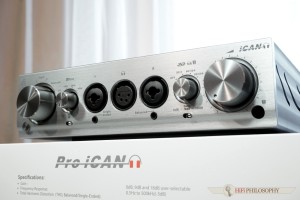
The owner of this amplifier has at his disposal up to six headphone outputs – three balanced and three single-ended.
So, half-heartedly I moved the slider to “Tube” position and then the sound became a bit lower and brighter. It also became more smooth, coherent, warm and closer, whereas the saxophone gained more air, playing closer to the trebles and attacking. It all became noticeably different and better in a few aspects, but still the “Transistor” mode won my full admiration. The lamp improved realism, supported by the closeness, but it was more in a sense of getting closer, not that it sounded better. Once more I moved the slider to “Tube+” mode and then two, or even three things changed. The sound became a bit more tough, darker, the textures became more rugged, deprived of softness. It wasn’t more rough, but kind of more grainy, which I liked quite a lot. What I didn’t like was that the saxophone became more quiet, keeping trebles peaks under control. I also reached (in “Tube” mode) for a song with enormous scene and reverb – and it was really convincing, without this circle over the head. The distanced perspective lays right before your eyes and the amazing sounds are contained in vast space. The music was at the same time close and spacious, also quite light, full of air, decay and charm.
Then I reached for AudioQuest NightHawk with balanced cable for a start, as they happen to have one. I only used “Tube” mode not to overload the amp with constant switching. From the first second I could feel noticeable improvement. In darker aura, under darker sky, the sound attacked more ferociously and was more versatile. As if the sound was brought in by more birds and they flapped their wings stronger. What’s more, it was more mysterious, with vigilant atmosphere. The bass was noticeably stronger and more prominent. The whole space was vibrating with it, becoming more vivid, and everything was bustling with rich musical life. But not to the extent to cause me lose my faith in HD 600, having in mind how much more joyfully they played. But NightHawks had more to offer, that goes without saying. I switched back from electro to vocal and saxophone – and I liked it less as the sound was more rumbling, which was again caused by the bass. It wasn’t as melodic as before with HD 600, showing the poor quality of the song, making me switch to “Transistor” mode, which caused the bass to calm down a bit and make everything more smooth. So with tubes different things can happen, and it’s not always the case that transistors are useless. However, in the case of NightHawk, it was “Tube+” that worked the best, combining together the profusion, dynamics and control over distortion. In general, it was slightly better than with HD 600, because, as I’ve mentioned, there was more going on and everything was closer, but the difference wasn’t great, that’s for sure. What was also better is that the mentioned circle has been lowered, moving closer to the head, eliminating the unpleasant feeling of sounds being above the head in some songs. I’ve also tried the headphones with unbalanced cable, which resulted in less prominent sounds and diminished profusion, proving that it all stemmed from balance. Therefore, HD 600 with a balanced cable would probably play better too, but because I don’t have one, I cannot tell for sure.
With Hegel HD30 DAC
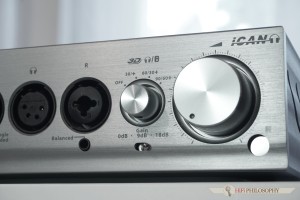
On the right side we find the volume and the gain control, as well as the already known 3D Holographic switch.
I’ve written about HifiMAN HE-6 and Audeze LCD-4 with Ayon in the review of the latter. Now I would like to invite them to a meeting with quite more expensive converter from Hegel. Of course more expensive doesn’t necessarily mean better, but it’s not a surprise when it turns out to be so.
Hegel HD30 will have its own review soon and then its pros and cons will be carefully assessed. Now I will only mention that the main difference between it and Ayon Sigma is in the style, as it is most of all pleasantly musical, and not boldly dynamic. So you could say that its style matches both flagship Audeze, which I will try out in a moment, together with planar HiFiMAN. But it wouldn’t be enough and there would be nothing corresponding to Sigma, so I’ve reached also for NightHawk. More importantly, before using the more expensive converter, I had a session with another amp, because, well, you just cannot predict the sound. You can’t guess how two devices will sound together, and even if you do, then it’s just luck. Of course, you can predict some things beforehand, but if I tried writing a review based on intuition, I would put myself into trouble. So with different amps and converters, you have to compare and only then you can have a better idea about them. Therefore I’ve checked Hegel converter with balanced amp from Phasemation and another one from Schiit that has been recently reviewed, so to have an idea about its style. In both sessions it turned out to be placid, subtle, with exceptional musical depth, not like Ayon Sigma with thunderous elements. Such a placid style has its advantages but also disadvantages. Placidness paired with subtlety, interlaced with light, pastel colors and sprinkled with warmth is very pleasant in reception and rather unique at the computer and always very expensive, it cannot, however, offer the full musical range. Because where are the peaks, charges, thumps? Where are bold accords and powerful orchestras? What good is creamy play when you want something spicy? A dessert is a part of a meal, but not the main course. So, with all sympathy towards delicate music, I felt like it lacked something, especially compared to the vigorous Sigma. However, as all audiophiles know, the art is to compose a well matched set of devices. So that the final effect coming out of the speakers is complete, not perfect in just one aspect. So that everything is in the right proportions. In this set, it is clear that ifi has turned out to be a better partner to Hegel. Better matched and filling the gaps. Because on its own it’s more aggressive and dynamic, and in “Tube+” mode it also plays more dark.
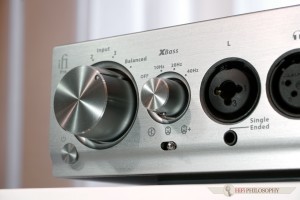
On the left we can select the input, adjust the gain of the lower registers and also choose a mode of operation.
But let me emphasize something really important here. I believe, and I’m pretty sure about it, that using ifi PRO, you shouldn’t stick to just one mode. Good quality records and top quality files can sound the best in the dark and more rough “Tube+”, whereas poorer quality gains a lot in “Tube” mode which is noticeably brighter and more smooth, with plenty of air. In general, it is more universal, but in some cases “Tube+” will play better, so it’s worth checking it out. Not in each case, but it can happen that “Tube+” will play better with a good material.
Sound Impression Continued
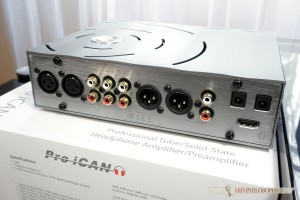
The rear panel is also well equipped, and to the right side hides a real curiosity – ESL output, which in the future will support electrostatic module!
Now let’s delve into the world of headphones, listing each by the name. I’ve used both Audeze, preceded by NighHawk, and then HE-6. It was good play, on high level, still having in mind how the NightHawk sounded with Sigma. But I must say that both headphones from Audeze, paired with Hegel, dominated over the rest.
Here I would like to add a personal remark. At times, my tolerance may differ. It would seem tolerance is valuable and appreciated, so it is a good thing to have it, but my tolerance is fluctuating and inconstant by nature. It gives me some trouble, because in the life of an audiophile it proves very useful and in the life of a reviewer – my good God – it is indispensable. Because with high tolerance one is pleased with everything and accepts everything. Therefore they would praise every equipment and listen to it with pleasure, arguing with those who dare to criticize anything. Such behavior is ostracism on equipment and has to be stomped out.
OK, I know I’m just fooling around and will be accused of picking on somebody. Nevertheless, I’ve noticed fluctuating tolerance in myself. It depends on the mood or the weather perhaps, but sometimes I’m more forgiving to poor quality stuff and at times I am a tyrant. This was the case when I was listening to both Audeze using Hegel and this big ifi. I was comparing using You Tube files, constantly switching between the two Audeze, because they were very similar and different at the same time, so I had to analyze them carefully. Arriving finally into some conclusions, I picked NighHawk again and then HiFiMAN.
The life of an audiophile can be full of surprises. Not long ago I saw that HE-6 and NightHawk compared to Audeze were pretty good. And now I felt like someone hit me in the head. A huge difference occured – and not for the first time – I’ve already mentioned that in LCD-4 review, when talking about Sigma, that other headphones cannot match with Audeze. These headphones, just like the older LCD-3, have such a character that they can highlight some differences at the computer, which was the case with Hegel. The difference is, however, that the older LCD-3 are more poetic and musical, whereas the new LCD-4 more firm and correct. I was listening to both with satisfaction and full attention, but I wasn’t aware that they were so much better. Only in comparison I realized how much more beautiful they sounded and how much realistic they were. The difference was huge, which I admit without satisfaction. But paired with Hegel, I wanted to listen only to them, sadly, the rest dropped out and I just couldn’t help it. After all, reviews are not to praise things but to describe one’s impressions – and here it was like I said, my tolerance was close to zero. I was surprised myself, because I like NightHawk and value HE-6 highly, but with PRO iCAN, both Sigma and Hegel converters showed the power of music hidden in Audeze. You might conclude that what the amp needs it for, is to let Audeze make the best of it. The tube Twin-Head doesn’t need it, but to the reviewed ifi it is very important. To put it differently, you could say ifi PRO iCAN is particularly good at objectively showing headphones’ abilities and hence the differences. It doesn’t add much of its own, but it brings out what’s already there, resulting in diversity and lack of tolerance. Of course, it doesn’t mean it can only play with Audeze and perhaps few others. It means that it highlights the differences and it is well audible. Especially when it comes to poor quality files, which couldn’t be improved even by the musical Hegel. It indicates the potential, which is so rarely visible in an amp. Let me just remind you how good it played with Sigma and HD 600, however, still having something in stock for Audeze.
With SACD player
Now lets move on to the player as it’s the most musical. With a converter worth 40k, with 12 chips. Its style of presentation is very close to Hegel, so there’s not much to say about differences, although they were definitely present. Supported with a dedicated, advanced drive, not the Blue-ray from Asus that was on the computer, it filled the sounds better and didn’t create the atmosphere of somewhat fake excitement. From the beginning, it offered better order and better surface feeling. After a few moments, as the amps warmed up, the sound has become richer than that on the computer, it was still more orderly, in a better organized space. The sound was also a bit more sweet and warm, whereas the brightness, texture feeling and overall atmosphere were almost identical. Identical and remarkably accurate, so the listening was most enjoyable. Poorer quality songs also showed that it was more musical when it comes to melody and harmonic flow, which even intensified the enjoyment.
I said amps, because according to my practice, I used two connected in parallel. I plugged ifi in with XLR cables from Tonalium, it had already warmed up at the computer from where I moved it quickly. I also connected Twin-Head with RCA cables from Siltech. Then I simply had to switch the headphones between the two to compare, which was quite easy as Twin-Head also has a 4-pin slot. I compared only with LCD-4, because they can tell the most about the sound, and also not to mess my head with too much data. I also figured I would use only “Tube” mode in ifi, as it is the most universal one, which allowed me to arrive at interesting conclusions.
The subject of this review is ifi PRO iCAN, so I focused my attention on it. What differences and similarities occurred in comparison to the reviewer’s referential tubes? In this matter I can repeat what I’ve said at the beginning. That I’m very pleased, this time in reference to maximalist music, not one from a computer, that such a top quality amp has arrived at the market and with a reasonable price. It costs almost half the price of the headphones that are currently plugged in, and is almost as good as Twin-Head, where the NOS tube set supported with Emission Labs triodes constitutes greater cost in itself.
For a long time it was not so successful premiere
I submerged myself into comparison, switching between dozens of records that are best for comparison. Twin-Head and ifi sounded very similar, which on the one head is a good thing, but on the other hand, there’s a certain irony in that. I was happy that the users can have such a good device for 8k, and I was at the same time angry that my own device worth about 30k is only slightly better. To be honest, before the tubes warmed up (I didn’t have the patience to wait), ifi turned out even better in some aspects. Here, I would like to focus on two key differences. The first is insignificant in the sense of overall quality, because it doesn’t affect it. In Twin-Head, the foreground was closer and the overall stage was greater. In ifi, the foreground was a bit distanced, heard from some perspective. The difference wasn’t big, however, but it was still clearly audible. It also put less emphasis on more distanced sounds, focusing on the close and medium stage. But again, the difference was not that explicit. With similar temperature and almost identical light, the two performances were very alike, with one significant difference. Namely, Twin-Head delivered perfectly clear, solid surface to the sounds. There was a clear barrier, but without being tough or tensed. They simply were there, existed. Human voice constituted a sphere, where you could examine its surface. It was beautifully shaped, perfectly reflecting the individuality of sounds and being invulnerable to overlap. You could say the voices were in solid state, very tangible and concrete. This resulted in complete personalization and real-life experience, where you don’t encounter transparent people. Whereas with ifi, the voices were more liquid-like, as if made of translucent liquid which you could see through. It was effective, although not necessarily realistic. What’s more, depending on the record and a particular voice, at times I liked more Twin-Head’s style and sometimes the one from iCAN. Surprisingly – on the same record Figaros Hochzeit (DG 423 874-2), the baritone of Dietricha Fischer-Dieskau was better with iCAN, whereas the wonderful soprano of Maria Stader sounded worse. But despite of this one prominent difference, I’ve noticed with great satisfaction how much beauty, individualism and good reverb iCAN is able to offer. The difference was quite considerable in comparison to a few days earlier, which means that it takes about a month to fully warm it up, no chance you can speed up the process. Tubes are tubes, and as a rule, you have to let the equipment play. But the final effect went beyond my expectations. Sure, my expectations regarding ifi PRO were high – after all the manufacturer has some accomplishments – but I haven’t expected that much. After an hour or so, Twin-Head started to show what it’s got. Then the curiosity and enjoyment increased, whereas the liquid transparency of voices in ifi started to be annoying. At first it was a pleasant differentiation, able to upstage the simplicity of Twin-Head, but when the latter has reached its full potential, it became less interesting, and kind of unrealistic.
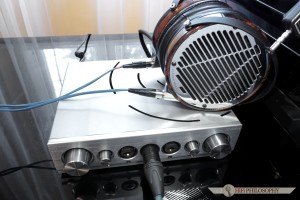
Essentially there is no question of any weaknesses – the whole sound is combined in a sophisticated cohesion.
Then I decided to do something that at first I haven’t planned. I switched into “Tube+” mode and then – I’m delighted to say – the voices in ifi also gained solidness and personalization. Therefore, with top quality sources and top quality cables, “Tube+” mode turns out to be the best. Whereas in less preferable conditions, it can be too tough and less open to sopranos, also not as smooth and kind of gloomy, as it has a dark color. All in all, it’s a good thing that ifi offers three modes, even the transistor mode seems to be just right with poorer quality headphones, and in general, it represents a very good standard. Whereas the two tube modes have the ability to adjust themselves to the equipment, each in its own way, which works to improve the overall compatibility.
At the end, I would like to say something about the utmost quality sound, because it’s something ifi with its music has motivated me to do. The way I see it, when you enter the orbit of excellent audio quality, you know you are there because you no longer feel the bad things, just like in space you don’t feel gravity. The things that pull you down and won’t let you jump. On audiophile orbit, there are no bad things holding you, and without them, you can fully devote yourself to listening. And then three things become important, constituting a quality mark in the audiophile universe. The first is the beauty, related to reverb. Because it is the right reverb and ability to rightly displace sounds on the dynamic waves that delivers the feeling of beauty, which is the most important. The second thing is giving the voices and sounds a familiar tone. I guess it is the simplest thing, and you are able to feel it right away. After all, everyone is able to recognize their friends’ voices on the phone or tell which audio equipment sounds the best. As long as you fully focus on that, it shouldn’t be problematic. And finally the third thing: the overall musical life. Not the basic sound, but the way it exists. They way the space is brought to life, the sources radiate and the virtual particles detach from the surface. The topological depth of textures, the background buzz and the buzz of the flow. The top quality performance must have it, it cannot just materialize and go on unchangingly. It has to constitute a visible flow, not just a picture. Not a collection of slides creating a musical action, but rather a foamy stream and gentle wind around you. Of course, it must be differentiated in volume depending on the moment, but even the silence cannot be dead. It still has to revive the space, because it is also the case in nature. The world we live in doesn’t allow completely empty and dead space. Even vacuum has some energy and void has a virtual creation, so the top quality equipment has to be able to reflect it. And again,
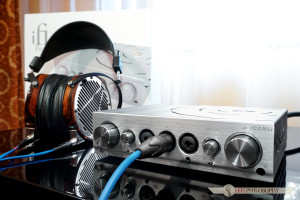
The cost of the latest iFi work isnt modest, but given its quality, we can talk about big affordability. Editorial recommendation!
I’m very pleased to say that all these things are present in ifi PRO iCAN. It didn’t sound dead even in silent moments, and the life of sounds was rich, buzzing and flowing. So those who buy it will enter the orbit where there is no bad gravity. Where you can experience pure magic of existence, in this case reflected in realistic sound and the intrinsic joy of listening to it.
Summary
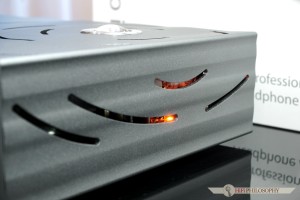 What is there to sum up? The problem with ifi PRO iCAN is that one would want a top quality converter, cables and headphones to go with it. Cables are the least problematic, because the ones I used for testing, freshly introduced Tonalium, are inexpensive, yet great. In general, there are lots of cables, for example the cheap Harmonix or the carbon First Ultimate can do very well. When it comes to the headphones, it is more difficult, although Sennheiser HD 600 showed that they are already pretty good. But it is still a far cry from the full possibilities of this amp. I’ve managed to determine that it particularly likes Audeze, but I’m sure there are many others on the market it would like as well. As far as the source is concerned, converters supporting files play the key role, but the manufacturer makes it easy for us, as a dedicated converter will be introduced soon. You don’t have to worry it won’t be well matching. Why would they mess up with a converter after making such a good amp? There will be also a dedicated power supply, probably with a battery for absolute peace of mind. Talking about power, what is a great advantage of the new iCAN is that it doesn’t need separate power supply cables, as it has its own. It’s a good thing because a decent cable costs about 2k, whereas good ones cost at least 5k. The money saved on cables can be spent on headphones, so that you can buy some really good ones, suitable to the excellent sound. Personally, I would recommend Audeze LCD-3, because LCD-4 are hideously expensive. But you would have to check it out, because maybe Ultrasone are better? Or Grado? Or the new HiFiMAN? There are plenty of headphones, I’m sure you will find some. You’re lucky there is this amp and it has my recommendation. For the sound, design and functionality, because it fully deserves it.
What is there to sum up? The problem with ifi PRO iCAN is that one would want a top quality converter, cables and headphones to go with it. Cables are the least problematic, because the ones I used for testing, freshly introduced Tonalium, are inexpensive, yet great. In general, there are lots of cables, for example the cheap Harmonix or the carbon First Ultimate can do very well. When it comes to the headphones, it is more difficult, although Sennheiser HD 600 showed that they are already pretty good. But it is still a far cry from the full possibilities of this amp. I’ve managed to determine that it particularly likes Audeze, but I’m sure there are many others on the market it would like as well. As far as the source is concerned, converters supporting files play the key role, but the manufacturer makes it easy for us, as a dedicated converter will be introduced soon. You don’t have to worry it won’t be well matching. Why would they mess up with a converter after making such a good amp? There will be also a dedicated power supply, probably with a battery for absolute peace of mind. Talking about power, what is a great advantage of the new iCAN is that it doesn’t need separate power supply cables, as it has its own. It’s a good thing because a decent cable costs about 2k, whereas good ones cost at least 5k. The money saved on cables can be spent on headphones, so that you can buy some really good ones, suitable to the excellent sound. Personally, I would recommend Audeze LCD-3, because LCD-4 are hideously expensive. But you would have to check it out, because maybe Ultrasone are better? Or Grado? Or the new HiFiMAN? There are plenty of headphones, I’m sure you will find some. You’re lucky there is this amp and it has my recommendation. For the sound, design and functionality, because it fully deserves it.
Point by point summary
Pros:
- High-end level sound.
- Exceptional in every aspect with the right source.
- Smoothly analog.
- Dynamic.
- Open.
- No tension.
- No trace of limited range.
- Absolutely no problems with trebles.
- Or bass shortages.
- Outstanding and rare, even on a high level, ability to individualize the sounds.
- Accompanied by full personalization and authenticity.
- Very good light – darker and lighter levels to choose from.
- Balanced atmosphere with a full range of emotions.
- Ability to show beauty.
- Excellent control over reverb and wonderful music flow.
- A hint of sweetness (coming mostly from the source).
- Pleasant, non-imposing warmth.
- Transparency and complex details.
- Wonderful, living space and the buzz of music flow.
- Organized stage with medium foreground.
- Differentiated textures: the most smooth in transistor mode, to rough, deeply trembling in Tube+ mode.
- You simply want to listen to it.
- Excellent technical parameters.
- Pure A class that can be switched to AB class.
- Nice, refined design.
- Small size.
- Considerable power on three levels.
- Suitable for any headphones, from in-ear to the most demanding planar.
- Energizer module will be available.
- Fully balanced.
- Three amplification modes, including two tube modes.
- A full set of headphone slots, including three balanced.
- Volume control from the remote.
- 3D and XBass processors.
- High quality external power supply.
- Excellent design and refinement.
- Reasonable quality and functionality to price ratio, allowing you to additionally cut back on power supply cable.
- Renowned manufacturer.
- Polish distributor.
- Ryka approved.
Cons and reservations
- Likes top quality headphones and sources.
- You have to wait a month till it warms up.
- The technically the best Tube+ mode is not always the best in a given configuration.
Technical parameters:
- Balanced headphone amplifier.
- Power supply: External DC 15V/4A.
- Inputs (back): 1 x XLR True Balanced Stereo, 3 x RCA Stereo.
- Outputs (front): 4-Pin XLR Headphone Balanced, Dual 3-Pin XLR Headphone Balanced
- 6.3 mm Headphone x 2, single ended or balanced 6.3mm to 3.5mm adapter included,
- 3.5 mm iEMatch attenuated x 2.
- Outputs (back): 1 x XLR True Balanced Stereo (preamp out), 1 x RCA Stereo (preamp out), Multipin Link connector for Energiser module.
- Volume control: Motorised ALPS 6-Way potentiometer.
- Amplification: 2 x GE 5670 Tube or 4 x Ultra Low Noise J-Fet, selected via front panel switch.
- Analog processing: X-Bass, +3dB at 80Hz, 160Hz, 320Hz; 3D Sound: 30/45/60 Degrees Virtual Speaker angle.
- Gain: 0 dB, 12 dB, 24 dB user-selectable.
- Signal to noise ratio: >117 dB.
- THD: <0.003%.
- Frequency Response: 0.5 Hz – 500 kHz (+-3dB).
- Output power: unbalanced outputs: 4.8 W; balanced 14 W.
- Output Voltage: 20V (Balanced); > 10V (single ended).
- Recommended price: 8590 PLN.
Test system:
- Sources: PC, Accuphase DP-700 SACD.
- Converters: Ayon Sigma DAC, Hegel HD30 DAC.
- Headphone amplifiers: ASL Twin-Head Mark III MOD, ifi PRO iCAN, Phasemation EPA-007, Schiit Ragnarok.
- Headphones: Audeze LCD-3 & LCD4, AudioQuest NightHawk, HiFiMAN HE-6, Sennheiser HD 600 & HD 800S.
- Interconnects: Siltech Queen Signature RCA, Sulek Audio RCA, Tellurium Q Black Diamond XLR, Tonalium Audio XLR.








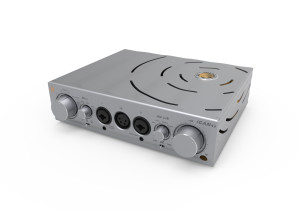
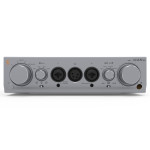
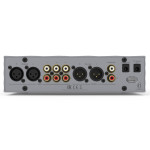
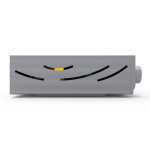
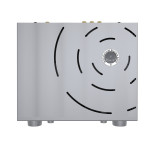
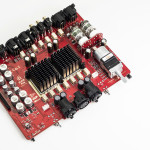
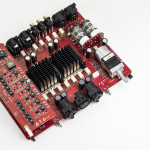
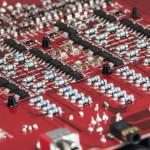
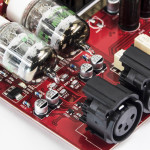
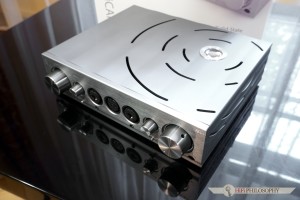
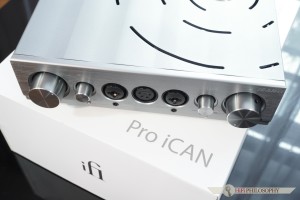
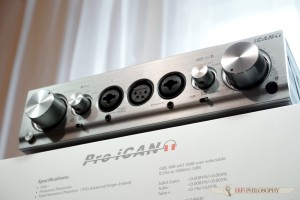

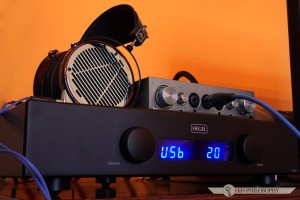
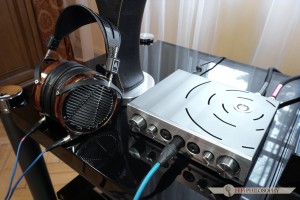
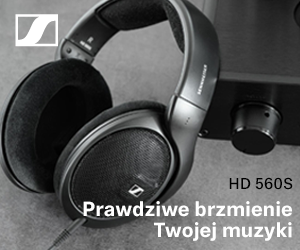

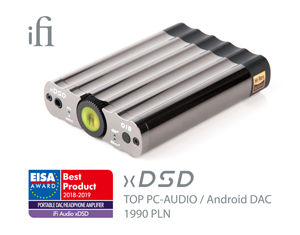


A w polish version też będzie ? 🙂
W polskiej już jest od jakiegoś czasu 🙂
http://hifiphilosophy.com/recenzja-ifi-pro-ican/
Dzięki ,chyba muszę częściej wchodzić na tę stronę bo nie ogarniam wszystkiego 🙂
Zapraszamy. Drzwi zawsze stoją otworem…